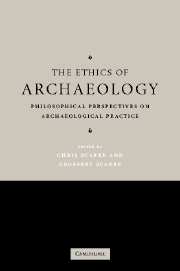Book contents
- Frontmatter
- Contents
- List of contributors
- Acknowledgements
- 1 Introduction
- PART I THE OWNERSHIP OF CULTURAL OBJECTS
- PART II ARCHAEOLOGISTS AND THE LIVING
- PART III ARCHAEOLOGISTS AND THE DEAD
- PART IV THE COMMON HERITAGE OF HUMANKIND?
- 13 A plea for responsibility towards the common heritage of mankind
- 14 The ethics of the World Heritage concept
- 15 What value a unicorn's horn? A study of archaeological uniqueness and value
- References
- Index
15 - What value a unicorn's horn? A study of archaeological uniqueness and value
Published online by Cambridge University Press: 05 June 2012
- Frontmatter
- Contents
- List of contributors
- Acknowledgements
- 1 Introduction
- PART I THE OWNERSHIP OF CULTURAL OBJECTS
- PART II ARCHAEOLOGISTS AND THE LIVING
- PART III ARCHAEOLOGISTS AND THE DEAD
- PART IV THE COMMON HERITAGE OF HUMANKIND?
- 13 A plea for responsibility towards the common heritage of mankind
- 14 The ethics of the World Heritage concept
- 15 What value a unicorn's horn? A study of archaeological uniqueness and value
- References
- Index
Summary
The cultural heritage and the natural heritage are among the priceless and irreplaceable possessions, not only of each nation, but of mankind as a whole. The loss, through deterioration or disappearance, of any of these most prized possessions constitutes an impoverishment of the heritage of all the peoples in the world. Parts of that heritage, because of their exceptional qualities, can be considered to be of outstanding universal value and as such worthy of special protection against the dangers which increasingly threaten them.
(UNESCO 1999: 1)Pressures on the archaeological resource, at both a national and an international level, have never been so great. Increasing population numbers, industrialisation, mechanised cultivation, expanding settlements and an international market for antiquities are causing immense destruction of archaeological sites and their contents. In reaction to this pressure, and the resultant losses, managers of the heritage resource have to make difficult decisions as to the selection and preservation of individual sites at international, national and even local levels. Many of these decisions are guided by national and international legislation such as Britain's Ancient Monuments and Archaeological Areas Act of 1979, its Planning (Listed Buildings and Conservation Areas) Act 1990 and UNESCO's 1972 Convention Concerning the Protection of the World Cultural and Natural Heritage. Despite some voiced misgivings concerning issues of criteria and value (Darvill 1995; Pressoyre 1996; Schaafsma 1989), most managers rely heavily on these instruments. This chapter will investigate the conceptual underpinnings of such legislation.
- Type
- Chapter
- Information
- The Ethics of ArchaeologyPhilosophical Perspectives on Archaeological Practice, pp. 260 - 272Publisher: Cambridge University PressPrint publication year: 2006
- 7
- Cited by

